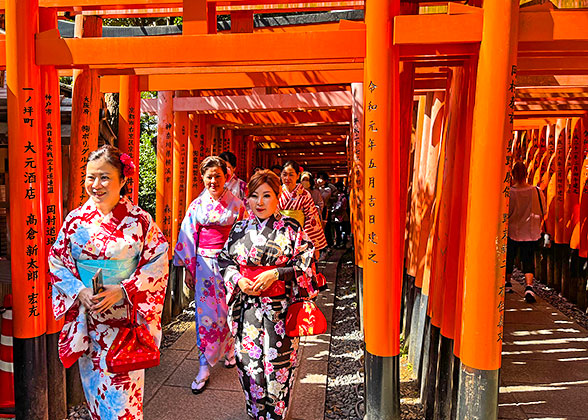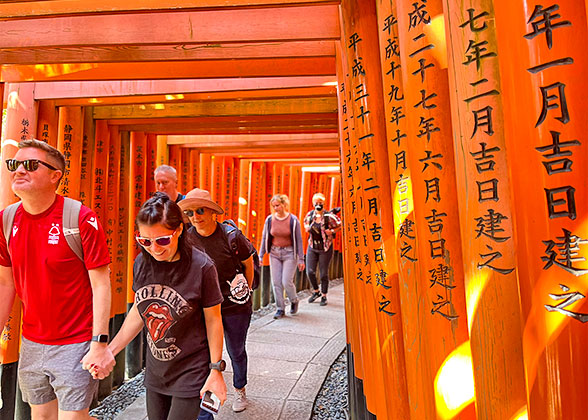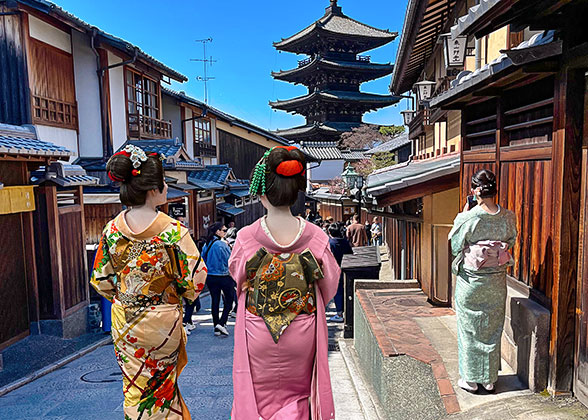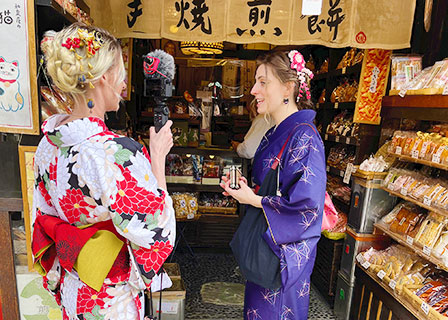Fushimi Inari Taisha

Fushimi Inari Taisha Photos ( 40
|
Origin of Fushimi Inari Taisha
It’s recorded that the history of Inari and Fushimi Inari Taisha started with an ancient clan called the Hata, which flourished from 2nd to 6th centuries in Japan. One day, an ancestor of the clan was shooting rice cakes to improve his archery skills. As he practiced, a pierced cake suddenly transformed into a swan, which flew and stopped on a mountain peak. Where the swan landed, rice began to grow – so did the story of Inari, who was considered the divine power associated with the growth. Later, the mountain was named Mt. Inari and Fushimi Inari Taisha constructed.Must-see Sights and Things to Do
The Romon Gate - The Magnificent Entrance
Built in 1589, the Romon Gate is the entrance leading to the shrine and one of the most magnificent of its kind in Japan. Before entering, remember to go through the ritual of rinsing your hands and mouth nearby as all visitors do, to show respect to the goddess that lives here.

The magnificent Romon Gate
|
Honde – the Main Shrine Building
Honored as an Important Cultural Property, the Honde is the main site where visitors pay tribute to Inari.Things to do at Honde:
![]() If you are interested in having your fortune told, go to the left of the building, draw a wooden stick from a wooden cylinder, and pay 200 yen to receive your paper reading. Honde can be very crowded during Japanese New Year (Jan. 1).
If you are interested in having your fortune told, go to the left of the building, draw a wooden stick from a wooden cylinder, and pay 200 yen to receive your paper reading. Honde can be very crowded during Japanese New Year (Jan. 1).
|
|
|
Senbon Torii / Thousands of Torii Gates – the Biggest Highlight
The biggest highlight in the shrine grounds and the most primary reason why travelers come. Stretching from behind Honde, thousands of vermillion torri gates can be seen covering the trails to the summit of Mt. Inari, mostly densely-packed. This cultural phenomenon was actually created by merchants since the Edo era (1603-1868), who donated the torri gates to thank Inari for granting their wishes.Things to do through Senbon Torii:
![]() Try local food in restaurants scattering along the torri pathway. Aburaage or fried tofu can be sampled here, said to be loved by foxes, messengers of Inari.
Try local food in restaurants scattering along the torri pathway. Aburaage or fried tofu can be sampled here, said to be loved by foxes, messengers of Inari.

Spectacle of densely-stacked torii gates
|
Okusha Hohaisho – the Inner Shrine
To the northeast of the main shrine building lies the shrine of Okusha Hohaisho, visited by Japanese people to pray to Mount Inari.Things to do at Okusha Hohaisho:
|
|
|
Ichinomine – the Shrine Attesting to Your Willpower
Quietly perching atop Mount Inari, Ichinomine is the last shine vistors see in the holy grounds. It is a reward for anyone who could climb this high.Kitsune Fox Statues
One feature of the shrine is its statues of fox, called kitsune in Japanese. As mentioned above, foxes are messengers of Inari, so it’s natural to find hundreds of these statues here and there across the grounds. An intimate look will make the observers discover something in their mouths: sometimes a key, other times bamboo, a scroll, or a sphere. The key symbolizes access to rice granaries, scroll wisdom, bamboo abundance, and sphere spiritual energy.
|
|
|
Festivals to Enjoy in Fushimi Inari Taisha
Here are listed the festivals held at different times in the shrine. These times just offer the best chances to experience Japanese ancient culture.
|
January |
1st: Saitan-sai (6:00 am); New Year prayer
5th: Oyama-sai; Ceremonies at main shrine building (12:00 pm) & Gozendani Kitoden prayer building (1:30 pm) |
|
Feburary |
Day before the the first day of Spring in Japanese lunar calendar: Setsubun-sai (9:00 am); A ceremony to chase away evil First Day of the Horse: Hatsuuma Taisai (8:00 am); Major festival, anniversary of the shrine's establishment |
|
April |
Sunday near the 8th day of the month: Sangyo-sai (1:00 pm); Show gratitude to Inari 12th: Minakuchi Hashu-sai (11:00 am); Plant rice seedlings and pray to InariSunday near the 12th day of the month: Inari-sai, Shinko-sai (11:00 am); The most important festival, on which portable Inari shrines are taken here to bless. |
|
May |
3rd: Inari-sai, Shinko-sai (4:00 pm) |
|
June |
10th: Taue-sai (1:00 pm); Move the planted rice seedlings to the shrine and pray to Inari 30th: Oharae-shiki (3:00 pm); The Summer Purification Rite to purify sins. |
|
July |
1st Sunday or holiday in July during Doyo (Dog days of summer): Motomiya-sai; A time when worshippers across Japan come here to thank Inari. |
|
November |
8th: Hitaki-sai (1:00 pm); A very popular ancient festival, when Inari is thanked and worshippers offer 100 thousand tablets to be burned for good fortune. 8th: Mikagura (6:00 pm); art performance for Inari23rd: Shinjo-sai (10:00 am); Offer harvested rice to Inari and celebrate. |
|
December |
31st: Oharae-shiki (3:00 pm); A ceremony to purify sins committed in the last half of this year |
Know Before Going
Opening hours: Open all the timeEntrance fee: Free
Time needed: 2-3 hours, hiking involved
Getting there
Take JR Nara Line (train): Get off at the Inari Station. It’s only 2 stations away from the Kyoto Station.Take Keihan Main Line (train): Get off at Fushimi-inari Station and walk east for 5 minutes.
Take Minami 5 Line (city bus): Get off at Inari Taisha-mae bus stop and walk east for 7 minutes.
Tip for Itinerary Planners
For travelers planning to add Fushimi Inari Taisha to your itinerary, don't forget to include Kiyomizu-dera Temple and Gion area (4 kilometers/2.5 miles away to the north). The former is a 1,200-year-old UNESCO-honored Buddhist temple sharing the same fame with Fushimi Inari Taisha, the latter Kyoto's busiest historic spot to experience Japanese Geisha culture and classy Japanese food.Recommended Route
If you decide to vist Fushimi Inari Taisha first, you can later let the Keihan Main Line drop you off at Gion-shijo Station to start from Gion; stop by Gion Shrine if you like, and stroll the ancient Ninenzaka and Sannenzaka streets that lead to Kiyomizu-dera Temple. Reverse the route according to your need.
Fushimi Inari Taisha Photos & more Kyoto Photos
Fushimi Inari Taisha Video






